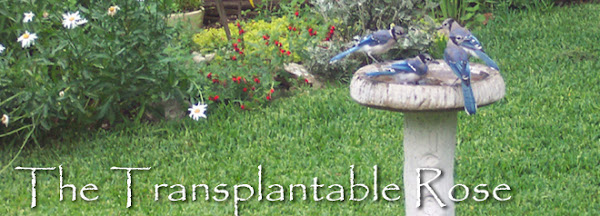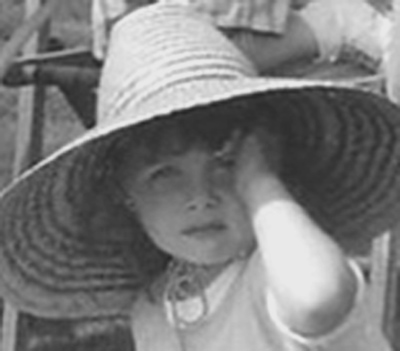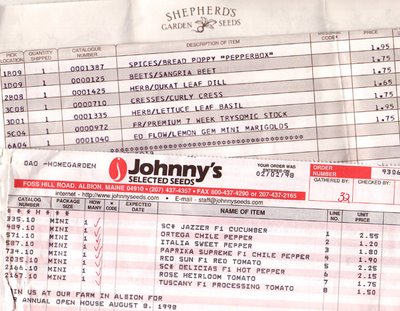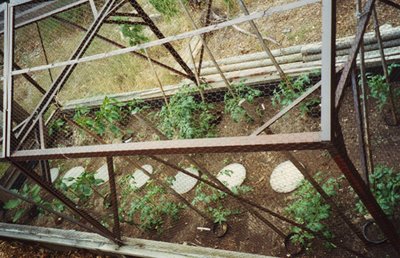 Philo remembers long drives to the small town where his grandfather lived, the small frame house and the garden with rows of beets and onions .
Philo remembers long drives to the small town where his grandfather lived, the small frame house and the garden with rows of beets and onions .I remember my grandmother's small Chicago garden with Swiss Chard and Rhubarb and parsley and remember 'helping' my aunt with her suburban garden.
 Where Philo and I grew up, even if there were no rows of vegetables, most yards had some kind of food plants - apple or pear trees, a grape vine for jelly, a clump of rhubarb or a raspberry thicket.
Where Philo and I grew up, even if there were no rows of vegetables, most yards had some kind of food plants - apple or pear trees, a grape vine for jelly, a clump of rhubarb or a raspberry thicket.Almost everyone had a tomato patch. I well remember the gross-out chore of picking hornworms off tomato leaves and there's a permanent photographic record of Philo's early success with tomatoes.
As newlyweds in the late 1960's we planted flowers and a few vegetables near the door of our aluminum graduate school hut and squeezed in a few tomatoes and flowers around a rented townhouse in the early 1970's. Once we bought a house on a quarter-acre of land, we could begin the first of 5 real kitchen gardens. In all five gardens we've dealt with clay soil, semi-shade, tree roots and ravenous animals. The first three houses were in the Western Suburbs of Chicago.
 Garden #1 (1973-1977) had several large wild cherry trees on the lot but there was a sunny place behind the garage to grow beans and tomatoes and squash and peppers.
Garden #1 (1973-1977) had several large wild cherry trees on the lot but there was a sunny place behind the garage to grow beans and tomatoes and squash and peppers. Garden #2 (1977-1987) was on a lot with old pear and crabapple trees and wild grape vines. Philo fitted the main bed into the semi-sunny corner of the back fence, eventually adding raspberry trellises and garden grapes.
Garden #2 (1977-1987) was on a lot with old pear and crabapple trees and wild grape vines. Philo fitted the main bed into the semi-sunny corner of the back fence, eventually adding raspberry trellises and garden grapes.  Another patch in sun on the opposite fence let the kids in the sandbox watch the zucchinis grow and a trellis on the side of the garage let us enjoy the new Sugar Snap peas.
Another patch in sun on the opposite fence let the kids in the sandbox watch the zucchinis grow and a trellis on the side of the garage let us enjoy the new Sugar Snap peas. At Garden #3 (1987-1999) we had a reasonably large space at the back of a long narrow lot. Even though the lot was overhung with wild cherries, mulberries and Box elders, this garden really pumped out peppers and tomatoes! Philo had all the salsa he could wish for but I never had enough zucchini. The fence helped keep out rabbits and groundhogs but couldn't save the squash from the squirrels.
At Garden #3 (1987-1999) we had a reasonably large space at the back of a long narrow lot. Even though the lot was overhung with wild cherries, mulberries and Box elders, this garden really pumped out peppers and tomatoes! Philo had all the salsa he could wish for but I never had enough zucchini. The fence helped keep out rabbits and groundhogs but couldn't save the squash from the squirrels.  Then we moved to Texas, and instead of owning arable land we lived in the deer-filled Austin hills. At Garden # 4 we did our best to grow a few peppers in pots on the deck and tomatoes inside this 4 and 1/2 foot tall, deer-resistant wire enclosure. The soaker hose failed in this situation and the deer nipped every leaf that dared to stray outside the wire.
Then we moved to Texas, and instead of owning arable land we lived in the deer-filled Austin hills. At Garden # 4 we did our best to grow a few peppers in pots on the deck and tomatoes inside this 4 and 1/2 foot tall, deer-resistant wire enclosure. The soaker hose failed in this situation and the deer nipped every leaf that dared to stray outside the wire.  Philo started our current Kitchen Garden #5 in fall 2004, a few months after we moved to this house and had Swiss Chard & tomatoes by June 2005. As usual, the plot isn't in full sun, the soil is heavy clay and tree roots creep in from the other side of the fence, but after 5 years of stooping over to fit into the wire house, this feels like a real garden!
Philo started our current Kitchen Garden #5 in fall 2004, a few months after we moved to this house and had Swiss Chard & tomatoes by June 2005. As usual, the plot isn't in full sun, the soil is heavy clay and tree roots creep in from the other side of the fence, but after 5 years of stooping over to fit into the wire house, this feels like a real garden! Instead of either Kitchen Garden or Victory Garden, Yolanda Elizabet uses the term Potager, encompassing not only her decorative vegetable plantings, but grapevines, fruit trees, cold frames, a greenhouse & conservatory. That very cool word may be a little too grand for a 9 X 10 sort-of-raised bed of tomatoes, peppers and a few salad vegetables. We have no greenhouse or conservatory but we've grown wonderful lemons, we hope each year for loquats, pomegranates and figs, were astonished by a crop of edible pecans one memorable autumn and all year long use the herbs planted in troughs and tucked into flower beds.
Instead of either Kitchen Garden or Victory Garden, Yolanda Elizabet uses the term Potager, encompassing not only her decorative vegetable plantings, but grapevines, fruit trees, cold frames, a greenhouse & conservatory. That very cool word may be a little too grand for a 9 X 10 sort-of-raised bed of tomatoes, peppers and a few salad vegetables. We have no greenhouse or conservatory but we've grown wonderful lemons, we hope each year for loquats, pomegranates and figs, were astonished by a crop of edible pecans one memorable autumn and all year long use the herbs planted in troughs and tucked into flower beds. Marjoram and thyme grow in the hypertufa trough above, along with a plant of Italian parsley shared by Rock Rose Jenny.
Marjoram and thyme grow in the hypertufa trough above, along with a plant of Italian parsley shared by Rock Rose Jenny.  No matter how long you garden, there are new things to learn. We no longer incorporate pecan leaves from our two large trees into the soil, but once the juglone-free Arizona Ash leaves fell this winter we had enough to redo part of the garden using a modified version of Renee's lasagna method.
No matter how long you garden, there are new things to learn. We no longer incorporate pecan leaves from our two large trees into the soil, but once the juglone-free Arizona Ash leaves fell this winter we had enough to redo part of the garden using a modified version of Renee's lasagna method.  We used timbers to hold up the 'lasagna' in two areas of the garden, one 3' X 4' square and another 2' X 3', making layers of existing soil, decomposed granite, various composts and the dry leaves, then watered regularly and waited.
We used timbers to hold up the 'lasagna' in two areas of the garden, one 3' X 4' square and another 2' X 3', making layers of existing soil, decomposed granite, various composts and the dry leaves, then watered regularly and waited. The front edge got a sprinkling of radish and spinach seeds, some shallots and a line of red onions. About 10 days ago I dug the rest of the bed over and made cedar mulch paths. I hunted around to find the soaker hose and decided to give it another try.
The front edge got a sprinkling of radish and spinach seeds, some shallots and a line of red onions. About 10 days ago I dug the rest of the bed over and made cedar mulch paths. I hunted around to find the soaker hose and decided to give it another try.  Last week Philo revised and reinforced the Tomato Scaffolding from last summer and we set it into place. On Sunday we planted a few tomato and pepper plants, adding more soil, compost and granite as we planted. 'Juliet' already has a few flowers but I'm still trying to decide whether it's a good idea in this climate to cover the soaker hose with mulch - what do you think?
Last week Philo revised and reinforced the Tomato Scaffolding from last summer and we set it into place. On Sunday we planted a few tomato and pepper plants, adding more soil, compost and granite as we planted. 'Juliet' already has a few flowers but I'm still trying to decide whether it's a good idea in this climate to cover the soaker hose with mulch - what do you think?  Even if the drought breaks, the intense summers mean we can't get yields in Austin like the ones in Illinois, but we'll enjoy whatever we can get!
Even if the drought breaks, the intense summers mean we can't get yields in Austin like the ones in Illinois, but we'll enjoy whatever we can get! In the back of the garden I'm experimenting with an old wooden box discarded by my youngest son and his friends. For years the guys kept it behind the shed, hauling it out once in awhile to use as a backstop. After long exposure to Austin weather one end started to rot off and the box was moved to the trash area, waiting for Bulky Trash Day. But then I had the idea to talk Philo into fixing the bad end and drilling drainage holes in the bottom. I lined it with roll window screen, put it near the fence where nothing ever grows, filled it with potting soil and even though it was a little late in the season, planted seeds. To keep the squirrels and birds out of it I covered the soil with some old racks from the garage.
In the back of the garden I'm experimenting with an old wooden box discarded by my youngest son and his friends. For years the guys kept it behind the shed, hauling it out once in awhile to use as a backstop. After long exposure to Austin weather one end started to rot off and the box was moved to the trash area, waiting for Bulky Trash Day. But then I had the idea to talk Philo into fixing the bad end and drilling drainage holes in the bottom. I lined it with roll window screen, put it near the fence where nothing ever grows, filled it with potting soil and even though it was a little late in the season, planted seeds. To keep the squirrels and birds out of it I covered the soil with some old racks from the garage.  On a recent visit my son took a look at the vegetable garden, and I showed him the seeds sprouting in the repurposed ammo box, saying that it might need a decorative sign.
On a recent visit my son took a look at the vegetable garden, and I showed him the seeds sprouting in the repurposed ammo box, saying that it might need a decorative sign.  My son knows me too well...he raised an eyebrow and asked, "Peas on Earth?"
My son knows me too well...he raised an eyebrow and asked, "Peas on Earth?" Pretty close - what I'd been thinking was "Give Peas A Chance".











 With this system, Philo grew interesting, hard-to-find varieties of tomatoes and peppers, and I was able to start perennials from seed, like Blackberry lilies, columbine, white coneflowers, Lychnis coronaria alba and splashy hardy Hibiscus.
With this system, Philo grew interesting, hard-to-find varieties of tomatoes and peppers, and I was able to start perennials from seed, like Blackberry lilies, columbine, white coneflowers, Lychnis coronaria alba and splashy hardy Hibiscus. 